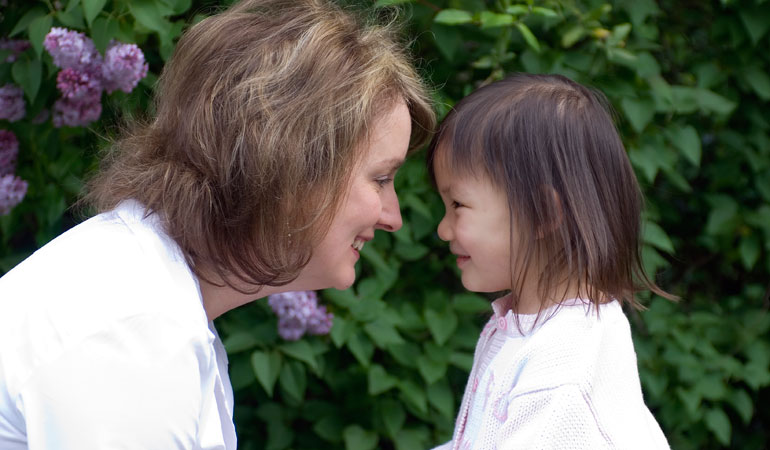“How will I talk to my child about adoption?”
This is a question every parent asks himself or herself. Even as your new baby takes her first steps, you wonder if you’ll be ready when the questions come. Soon you realize that your child is simply your child, not your “adopted” child, and it becomes difficult even to imagine an adoption talk.
But you’ll have this conversation, not just once, but over time, offering more information as your child matures. Sometimes its coming will take you by surprise, launched by the query of a curious child. Sometimes you’ll see an opening and take it, offering the chance to talk if the feelings fit. The key here is comfort, to create an atmosphere of openness and warmth in which both parent and child feel free to approach a hard topic.
What if you miss an opportunity? What if a question is asked and you deflect a thought? Relax. You have a whole childhood in which to talk. Sometime between ball games and play dates, math tests and family reunions, you’ll have your conversations.
In a way, talking about adoption is like dancing with your child. Sometimes he leads and you follow. Sometimes it’s the reverse. And with each conversation, successfully joined, the dance will become more graceful. So go ahead, take that first step.
DIRECTED PLAY: Following a child’s lead
Three- to five-year-olds often use words without having a clear idea of what they mean. The goal with even the youngest child is to create a healthy intimacy. A preschooler feels like the star of his own adoption story when it is presented as something that makes his parents happy. And don’t be fooled by their using the right words. Research makes it clear they are sometimes mimicking more than understanding.
Haley, at four, is delicious. All seriousness and concentration, she cooks our breakfast at her toy stove in the backyard — sand oatmeal, pebble popovers, squashed raspberries, pretend vanilla ice cream. Pouring cold water tea from a red flowered pot into thimble-size cups, she serves up her feast as grandly as a queen.
I take imaginary sips from my little cup. We have time today to do anything we choose, the sun is shining, and I’m filled with every wonderful, astonishing, miraculous inch of her. It’s hard to keep from scooping her up and holding her close. Then she says gravely, “Remember when I came out of Daddy’s tummy?”
Curiously, I am not panic-stricken. What do I say? How do I say it? I think. I breathe. I pay attention. I tell myself, “This is not the only chance I will have to talk about adoption.”
“Haley, you didn’t come out of Daddy’s tummy. Only mommies can grow babies inside of their bodies, not daddies. I’ve been your mommy since you were born, but you were not in my body either. Daddy and I adopted you. Your birth mommy, Ellie, carried you in her body, and when you were ready to be born, you came out of her.”
“Nope, your body,” Haley insisted. “If I wasn’t in Daddy, I was in you.”
“I can see how you might have thought that,” I said. “Actually, Daddy and I came to get you at the hospital when Ellie gave birth to you. You grew inside your birth mommy, just like all babies do. And when it was time for you to be born, you came out of your birth mommy, just like all babies do”.
“Ellie was sad that she couldn’t take you home with her and care for you, but she couldn’t. She didn’t think she could take care of you in the ways she knew you would need. So she picked us to be your other real mommy and daddy forever.”
“What did you say when you first saw me?”
“We said, ‘How amazing! How wonderful! You are our most important dream come true! We are so happy!’ And we wrapped you in your yellow blankie and drove home very, very carefully, right to the place where you were going to be forever. With us, your very real parents!”
“Oh,” she said, relaxing against me. “Would you care for some more tea?”
The best way to read children’s feelings about adoption is by their actions rather than their words. To know what your child is thinking, play with her. Use dolls, stuffed animals, puppets, scarves, trucks — whatever toys she enjoys making up stories with. Let her be the boss and tell you what your character in the story should do.
For example, if she asks you to be a lost puppy, while she is the mother dog, ask her how to do it. Rather than initiating the pretend plot, ask your child if the puppy is scared, or worried, or hungry. Your child will probably be delighted to be in charge and direct your actions.
Follow your child’s lead and don’t push to give the story a happy ending. You want to learn how she interprets the situation. You may be surprised but try not to seem distressed. Remember, this is a window into your child’s thinking at this one moment. If the story is unhappy or anxiety-provoking, come back to it later. Over time you will have opportunities to clarify and expand understanding.
SHARE YOUR FEELINGS: Leading by example
When I picked Jordan up from school that day, I hoped he couldn’t see how crummy I felt. During a visit that morning, my aunt had implied that I could never love Jordan as much as I would a child who was born into our family. She talked about blood being thicker than water. I felt hurt and angry. I was doing my best to hide it — afraid my little boy would pick up on it.
“What’s wrong, Mom?” he asked.
“Nothing, honey. Don’t worry about it.”
We drove in silence for a while, me not trusting myself to say more, Jordan seemingly absorbed in his own thoughts. During our long drive home, I had a lot on my mind, and I could tell Jordan was concerned by my silence. I wondered if I should share my feelings with him.
Wasn’t it up to me to protect him from the hurtful views some people have of adoption and not to burden him with adult concerns? On the other hand, we always asked Jordan to share his own feelings.
“Are you okay, Mom?” he asked again.
“Sometimes it’s hard to talk about things, honey, but thank you for asking. Something upsetting happened to me today. I’ll try my best to tell you about it, but I’m embarrassed, hurt, angry, and sad all at once. It doesn’t have anything to do with you. Someone I thought was close to me said some stupid things about my not being a real mother, and it really hurt my feelings. Some people just don’t understand that you are my real son, I guess.”
“Oh,” he said. A few minutes later he added, “I wonder if it’s like how I feel when kids ask me why my real mom didn’t want me?” I was astonished.
“Maybe.”
“Why didn’t my birth mom want me, Mom? Do you think maybe I cried too much?”
Wow, I thought. Jordan had never mentioned this before. With a sigh, I reached over to rub his back.
“Babies are supposed to cry,” I said. “Crying is how babies tell us they need something before they can talk. Sometimes when a baby is born, his parents have problems that keep them from being able to take care of him. It’s not ever the child’s fault.”
Jordan and I were quiet the rest of the way home. We held hands across the seat, and we both had a feeling that something important had happened. When we got home, as we were getting out of the car, Jordan said, “I’m glad you told me, Mom. I like it when you tell me how you feel, even if you feel sad.”
“Me too,” I said.
One way to take the lead in the adoption talk is to offer your own experiences of being an adoptive parent, both the happy and the sad. Disclosing difficulties often has more impact than sharing only joyous feelings. Kids know it’s not easy to talk about the hard stuff, and they feel honored to receive “privileged information.”
It’s important, too, to give permission to express their concerns about birth parents without denying their feelings or trying to fix things. Parents can show that they accept their children’s feelings with an empathetic sigh or hug, a soft exclamation, or just by saying “What a way to feel.” When parents share painful as well as joyous experiences, children feel free to follow.
THE CASUAL COMMENT: Lead by opening topics you think matter
Another way to lead is by making casual comments and letting them resonate. Your child may not respond to these at all. Nonetheless, by putting them out there, you are saying you are ready to discuss these issues when they are. Do this often, simply by thinking out loud about things you’ve read or seen on TV, your child’s genetic inheritance, or feelings. Here are some examples:
“You’re such a talented pianist, and now you’re even composing your own songs. I wonder if someone in your birth family was a musician.”
“I always think about your birth mother when it’s time for your birthday. I wonder if you think about her, too.”
“I read that lots of adopted kids think it’s their fault they got placed for adoption.”
Adoption is but one aspect of your family’s life. Remember, the goal is to create a reasonable balance between talking about adoption and just living daily life. Ask yourself, when was the last time adoption came up? If you can’t remember, it’s probably time to raise the subject.
But none of us is defined by a single feature of our lives. We are parents first, not adoptive parents. Never forget your most important job — creating the close family you dreamed of when you began the journey toward adoption. Life is a gift. Our children are treasures. Cherish them above all.


